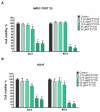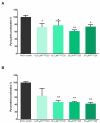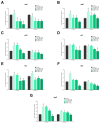FTY720 Reduces the Biomass of Biofilms in Pseudomonas aeruginosa in a Dose-Dependent Manner
- PMID: 39061303
- PMCID: PMC11273553
- DOI: 10.3390/antibiotics13070621
FTY720 Reduces the Biomass of Biofilms in Pseudomonas aeruginosa in a Dose-Dependent Manner
Abstract
Pseudomonas aeruginosa, a nosocomial pathogen, has strong biofilm capabilities, representing the main source of infection in the human body. Repurposing existing drugs has been explored as an alternative strategy to combat emerging antibiotic-resistant pathogens. Fingolimod hydrochloride (FTY720), an immunomodulatory drug for multiple sclerosis, has shown promising antimicrobial effects against some ESKAPE pathogens. Therefore, the effects of FTY720 on the biofilm capabilities of Pseudomonas aeruginosa were investigated in this study. It was determined that FTY720 inhibited the growth of P. aeruginosa PAO1 at 100 µM. The significant reduction in PAO1 cell viability was observed to be dose-dependent. Additional cytotoxicity analysis on human cell lines showed that FTY720 significantly reduced viabilities at sub-inhibitory concentrations of 25-50 µM. Microtiter assays and confocal analysis confirmed reductions in biofilm mass and thickness and the cell survivability ratio in the presence of FTY720. Similarly, virulence production and biofilm-related gene expression (rhlA, rhlB, pilA, pilI, fliC, fliD and algR) were determined. The results demonstrate that pigment production was affected and quantitative real-time PCR analysis showed a variable degree of reduced gene expression in response to FTY720 at 12.5-50 µM. These findings suggest that FTY720 could be repurposed as an alternative antibiofilm agent against Pseudomonas aeruginosa.
Keywords: FTY720; Pseudomonas aeruginosa; biofilm biomass; biomass reduction; fingolimod.
Conflict of interest statement
The authors declare no conflicts of interest.
Figures









Similar articles
-
In vitro and in vivo antibiofilm activity of the synthetic antimicrobial peptide WLBU2 against multiple drug resistant Pseudomonas aeruginosa strains.BMC Microbiol. 2023 May 15;23(1):131. doi: 10.1186/s12866-023-02886-x. BMC Microbiol. 2023. PMID: 37183241 Free PMC article.
-
Musa acuminata and its bioactive metabolite 5-Hydroxymethylfurfural mitigates quorum sensing (las and rhl) mediated biofilm and virulence production of nosocomial pathogen Pseudomonas aeruginosa in vitro.J Ethnopharmacol. 2020 Jan 10;246:112242. doi: 10.1016/j.jep.2019.112242. Epub 2019 Sep 15. J Ethnopharmacol. 2020. PMID: 31533077
-
Meloxicam inhibits biofilm formation and enhances antimicrobial agents efficacy by Pseudomonas aeruginosa.Microbiologyopen. 2018 Feb;7(1):e00545. doi: 10.1002/mbo3.545. Epub 2017 Nov 27. Microbiologyopen. 2018. PMID: 29178590 Free PMC article.
-
N-acetylcysteine (NAC) attenuates quorum sensing regulated phenotypes in Pseudomonas aeruginosa PAO1.Heliyon. 2023 Feb 28;9(3):e14152. doi: 10.1016/j.heliyon.2023.e14152. eCollection 2023 Mar. Heliyon. 2023. PMID: 36923901 Free PMC article.
-
A novel in silico antimicrobial peptide DP7 combats MDR Pseudomonas aeruginosa and related biofilm infections.J Antimicrob Chemother. 2020 Nov 1;75(11):3248-3259. doi: 10.1093/jac/dkaa308. J Antimicrob Chemother. 2020. PMID: 32737484
Cited by
-
Lovastatin and Resveratrol Synergistically Improve Wound Healing and Inhibit Bacterial Growth.Int J Mol Sci. 2025 Jan 20;26(2):851. doi: 10.3390/ijms26020851. Int J Mol Sci. 2025. PMID: 39859566 Free PMC article.
References
LinkOut - more resources
Full Text Sources

